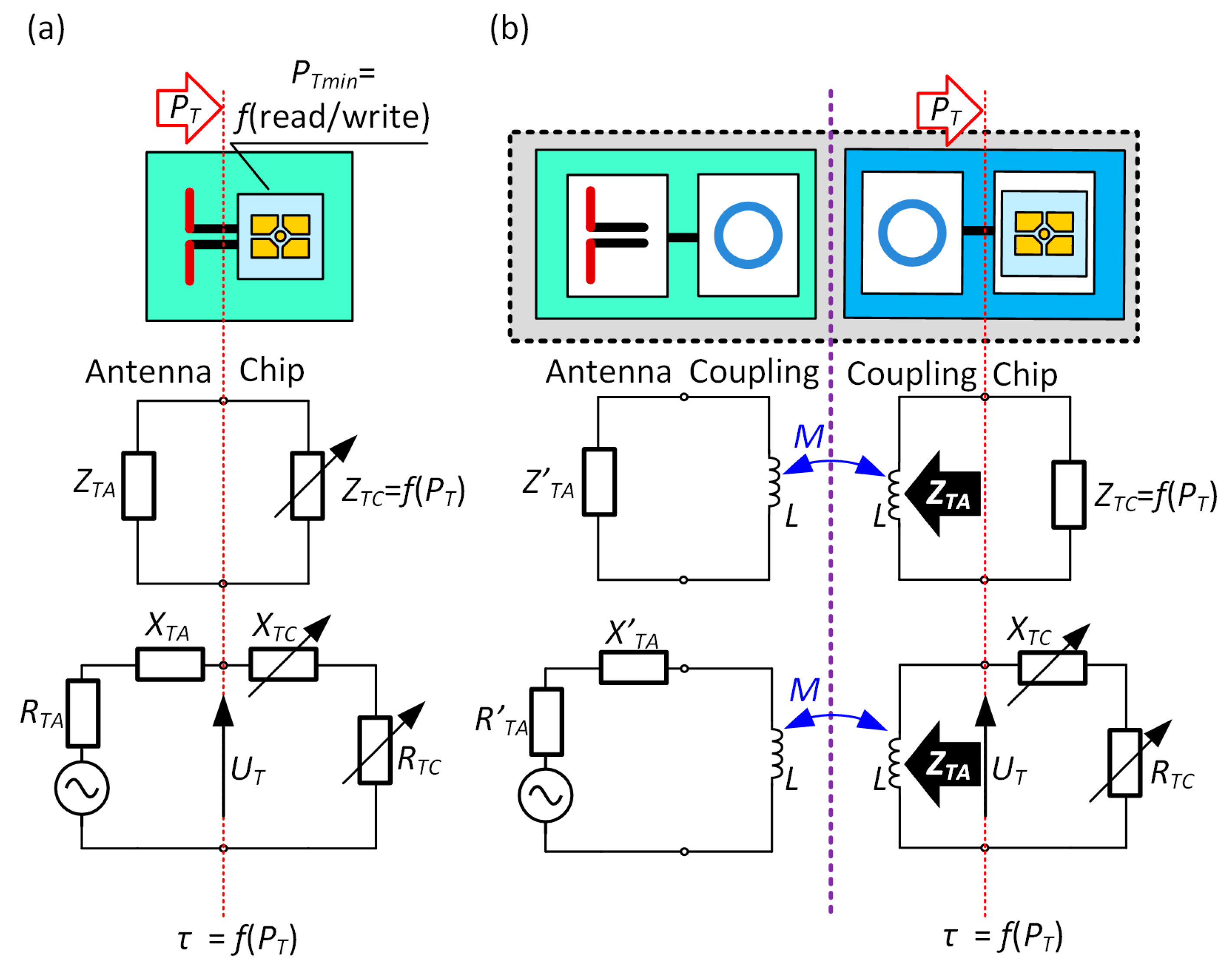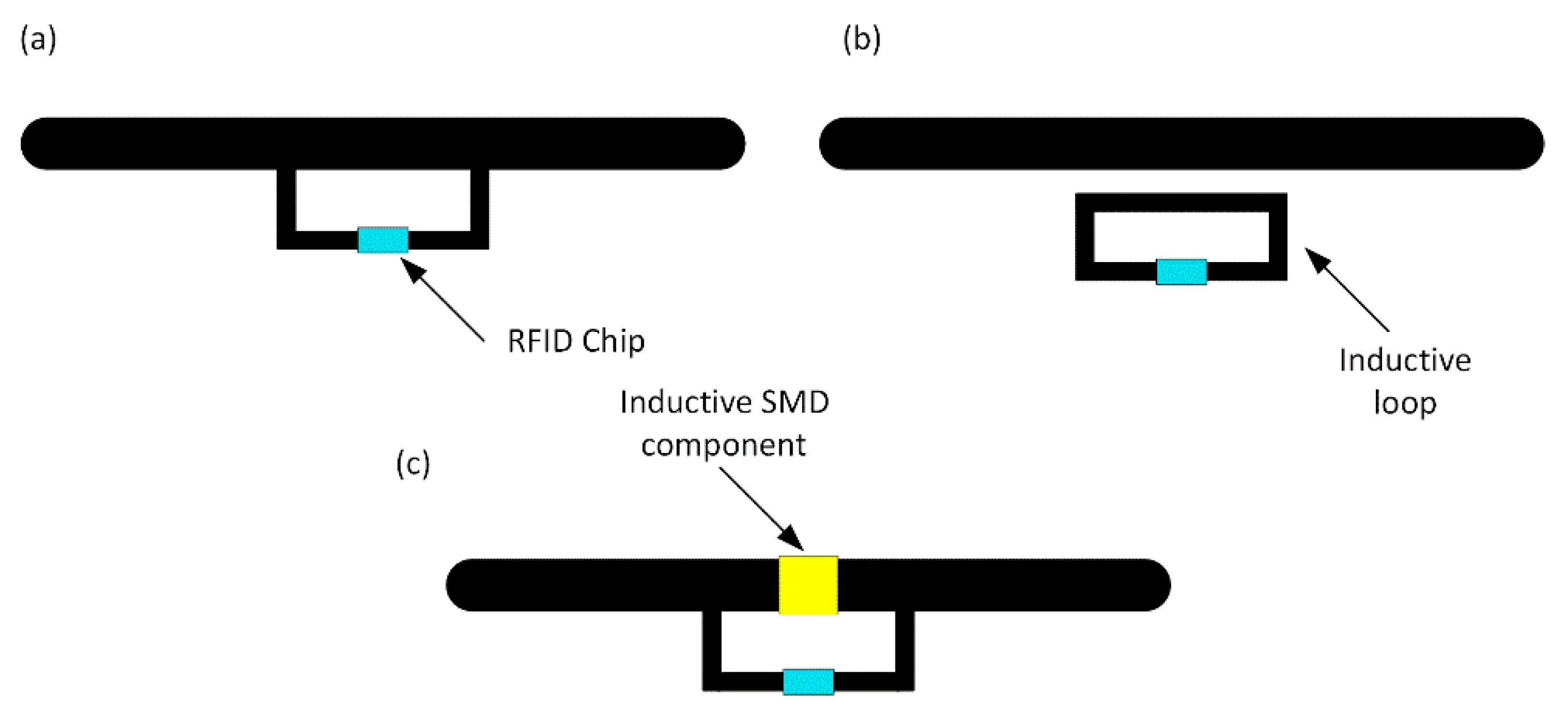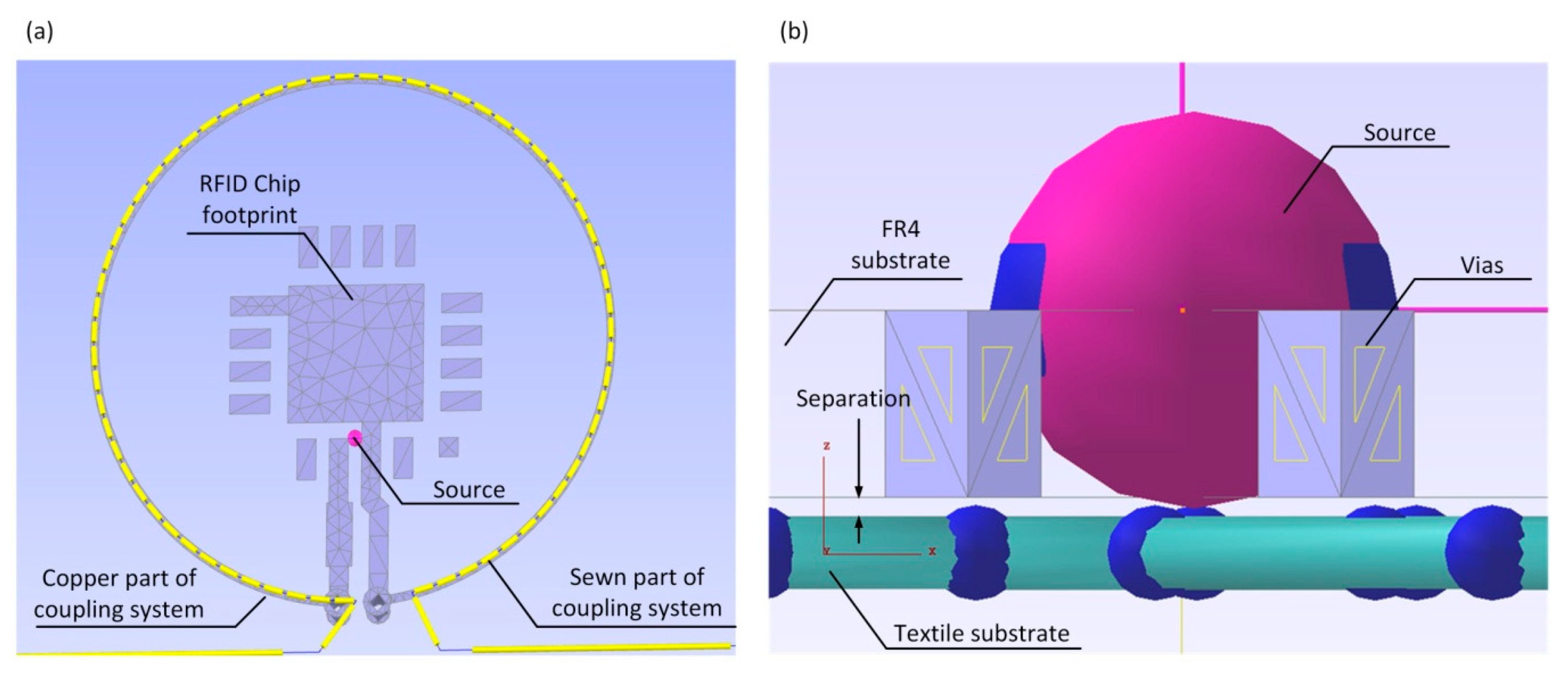Textronic UHF RFID Transponder
Abstract
:1. Introduction
1.1. Purpose of the Work
1.2. Textile UHF RFID Transponder
1.3. State of the Art
2. Materials and Methods
2.1. Impedance Matching
2.2. Antenna Construction for Textile UHF RFID Transponder with Coupling System
2.3. Design Assumptions and Numerical Calculations
3. Results
3.1. RFID Transponder Manufacturing
3.2. RFID Antenna Impedance Measurements
3.3. Experiment Setup
3.4. Threshold Measurements
3.5. Rotation Measurements
4. Discussion and Conclusions
- comprehensive parameterization of all materials (substrates and threads) with experimental verification at every stage;
- the possibility of simplifying wired model of conductive threads on the basis of performed investigations;
- full determination (numerical calculations and measurement) of parameters with their critical evaluation in the operational context, which is to lead to implementation in the industry.
5. Patent
Author Contributions
Funding
Institutional Review Board Statement
Informed Consent Statement
Data Availability Statement
Conflicts of Interest
References
- Tak, J.; Choi, J. An All-Textile Louis Vuitton Logo Antenna. IEEE Antennas Wirel. Propag. Lett. 2015, 14, 1211–1214. [Google Scholar] [CrossRef]
- Koncar, V. Smart Textiles and Their Applications, 1st ed.; Woodhead Publishing: Cambridge, UK, 2016; p. 746. [Google Scholar]
- Dias, T. Electronic Textiles: Smart Fabrics and Wearable Technology, 1st ed.; Woodhead Publishing: Cambridge, UK, 2015; p. 156. [Google Scholar]
- Benouakta, S.; Hutu, F.; Duroc, Y. New Approaches for Augmented UHF RFID Textile Yarn. In Proceedings of the IEEE International Conference on RFID Technology and Applications, RFID-TA, Pisa, Italy, 25–27 September 2019; pp. 136–140. [Google Scholar] [CrossRef]
- Ahmed, S.; Mehmood, A.; Sydänheimo, L.; Ukkonen, L.; Björninen, T. Glove-Integrated Textile Antenna with Reduced SAR for Wearable UHF RFID Reader. In Proceedings of the IEEE International Conference on RFID Technology and Applications, RFID-TA, Pisa, Italy, 25–27 September 2019; pp. 231–235. [Google Scholar] [CrossRef]
- He, H.; Chen, X.; Ukkonen, L.; Virkki, J. Clothing-Integrated Passive RFID Strain Sensor Platform for Body Movement-Based Controlling. In Proceedings of the IEEE International Conference on RFID Technology and Applications, RFID-TA, Pisa, Italy, 25–27 September 2019; pp. 236–239. [Google Scholar] [CrossRef]
- Simorangkir, R.B.V.B.; Le, D.; Björninen, T.; Sayem, A.S.M.; Zhadobov, M.; Sauleau, R. Washing Durability of PDMS-Conductive Fabric Composite: Realizing Washable UHF RFID Tags. IEEE Antennas Wirel. Propag. Lett. 2019, 18, 2572–2576. [Google Scholar] [CrossRef]
- Brechet, N.; Ginestet, G.; Torres, J.; Moradi, E.; Ukkonen, L.; Björninen, T.; Virkki, J. Cost- and time-effective sewing patterns for embroidered passive UHF RFID tags. In Proceedings of the International Workshop on Antenna Technology: Small Antennas, Innovative Structures, and Applications, iWAT, Athens, Greece, 1–3 March 2017; pp. 30–33. [Google Scholar] [CrossRef]
- Abbas, B.K.; Khamas, S.; Ismail, A.; Sali, A. Full Embroidery Designed Electro-Textile Wearable Tag Antenna for WBAN Application. Sensors 2019, 19, 2470. [Google Scholar] [CrossRef] [Green Version]
- Kuang, Y.; Ma, S.; Ukkonen, L.; Virkki, J.; Björninen, T. Circularly Polarized Textile Tag Antenna for Wearable Passive UHF RFID Systems. In Proceedings of the International Applied Computational Electromagnetics Society Symposium, ACES, Beijing, China, 29 July–1 August 2018; pp. 1–2. [Google Scholar] [CrossRef]
- Lagha, F.; Beldi, S.; Latrach, L. Design of UHF RFID body-worn textile tag for wireless applications. In Proceedings of the IEEE International Conference on Design & Test of Integrated Micro & Nano-Systems, DTS, Gammarth-Tunis, Tunisia, 28 April–1 May 2019; pp. 1–4. [Google Scholar] [CrossRef]
- Jiang, Y.; Leng, T.; Fang, Y.; Hu, Z.; Xu, L. Machine Embroidered Wearable e-textile Wideband UHF RFID Tag Antenna. In Proceedings of the IEEE International Symposium on Antennas and Propagation and USNC-URSI Radio Science Meeting, Atlanta, GA, USA, 7–12 July 2019; pp. 643–644. [Google Scholar] [CrossRef]
- Casula, G.A.; Montisci, G.; Rogier, H. A Wearable Textile RFID Tag Based on an Eighth-Mode Substrate Integrated Waveguide Cavity. IEEE Access 2020, 8, 11116–11123. [Google Scholar] [CrossRef]
- Sam, R.; Hazra, A.; Nesasudha, M. Design and Development of Textile Antenna for RFID Applications. In Proceedings of the 2nd International Conference on Signal Processing and Communication, ICSPC, Coimbatore, India, 29–30 March 2019; pp. 178–181. [Google Scholar] [CrossRef]
- Moraru, A.; Helerea, E.; Ursachi, C. Passive RFID Tags for Textile Items—Requirements and Solutions. In Proceedings of the International Symposium on Fundamentals of Electrical Engineering, ISFEE, Bucharest, Romania, 1–3 November 2018; pp. 1–6. [Google Scholar] [CrossRef]
- Jankowski-Mihułowicz, P.; Węglarski, M.; Chamera, M. Developing the idea of wire textile RF circuits and antennas fabricated by sewing conductive threads. In Proceedings of the 13th Conference “Electron Technology” ELTE & 43rd International Microelectronics and Packaging IMAPS Poland Conference, Wrocław, Poland, 4–6 September 2019; Walczak, R., Malecha, K., Eds.; Technical Digest: Kraków, Poland, 2019; pp. 125–126. [Google Scholar]
- Tsolis, A.; Whittow, W.G.; Alexandridis, A.A.; Vardaxoglou, J.C. Embroidery and Related Manufacturing Techniques for Wearable Antennas: Challenges and Opportunities. Electronics 2014, 3, 314–338. [Google Scholar] [CrossRef] [Green Version]
- Ginestet, G.; Brechet, N.; Torres, J.; Moradi, E.; Ukkonen, L.; Bjorninen, T.; Virkki, J. Embroidered Antenna-Microchip Interconnections and Contour Antennas in Passive UHF RFID Textile Tags. IEEE Antennas Wirel. Propag. Lett. 2017, 16, 1205–1208. [Google Scholar] [CrossRef] [Green Version]
- Jankowski-Mihułowicz, P.; Węglarski, M. Factors affecting the synthesis of autonomous sensors with RFID interface. Sensors 2019, 19, 4392. [Google Scholar] [CrossRef] [Green Version]
- GS1 EPCglobal. EPC Radio-Frequency Identity Protocols Generation-2 UHF RFID; Specification for RFID Air Interface Protocol for Communications at 860 MHz–960 MHz, ver. 2.1; EPCglobal: Brussels, Belgium, 2018. [Google Scholar]
- Finkenzeller, K. RFID Handbook—Fundamentals and Applications in Contactless Smart Cards. Radio Frequency Identification and Near-Field Communication, 3rd ed.; Wiley: Chichester, UK, 2010; p. 478. [Google Scholar]
- Choo, J.; Ryoo, J. Analysis of Flip Chip Bonding for Performance Stability of UHF RFID Tags. IEEE Trans. Compon. Packag. Manuf. Technol. 2014, 4, 1714–1721. [Google Scholar] [CrossRef]
- Oppert, T.; Azdasht, G.; Zakel, E.; Teutsch, T. Laser assisted soldering and Flip-Chip attach for 3-D packaging. In Proceedings of the 31st IEEE/CPMT International Electronics Manufacturing Technology Symposium, Petaling Jaya, Malaysia, 8–10 November 2006; p. 86. [Google Scholar] [CrossRef]
- Wang, Y.; Gauch, M.; Ristau, D.; Overmeyer, L. Fine-pitch chip-on-flex packaging of optoelectronic devices using low temperature optodic bonding. In Proceedings of the Pan Pacific Microelectronics Symposium, Big Island, HI, USA, 25–28 January 2016; pp. 1–9. [Google Scholar] [CrossRef]
- Jankowski-Mihułowicz, P.; Kawalec, D.; Węglarski, M. Antenna Design for Semi-Passive UHF RFID Transponder with Energy Harvester. Radioengineering 2015, 24, 722–728. [Google Scholar] [CrossRef]
- Moussa, M.S.; Kouki, A.B. A microstrip tag antenna for RFID applications in health care. In Proceedings of the International Conference on Microelectronics, ICM, Hammamet, Tunisia, 19–22 December 2011; pp. 1–6. [Google Scholar] [CrossRef]
- Jankowski-Mihułowicz, P.; Tomaszewski, G.; Węglarski, M. Flexible Antenna Design for HF RFID Semi-Passive Transponder in Ink-Jet Technology. Przegląd Elektrotechniczny 2015, 4, 1–5. [Google Scholar] [CrossRef] [Green Version]
- Kopyt, P.; Salski, B.; Olszewska-Placha, M.; Janczak, D.; Sloma, M.; Kurkus, T.; Jakubowska, M.; Gwarek, W. Graphene-Based Dipole Antenna for a UHF RFID Tag. IEEE Trans. Antennas Propag. 2016, 64, 2862–2868. [Google Scholar] [CrossRef]
- Akbari, M.; Virkki, J.; Khan, M.W.A.; Sydänheimo, L.; Ukkonen, L. Towards eco-friendly and cost-effective passive RFID applications. In Proceedings of the 10th European Conference on Antennas and Propagation, EuCAP, Davos, Switzerland, 10–15 April 2016; pp. 1–4. [Google Scholar] [CrossRef]
- Jiang, Y.; Hu, L.; Pan, K.; Leng, T.; Li, Y.; Danoon, L.; Hu, Z. e-Textile embroidered wearable near-field communication RFID antennas. IET Microw. Antennas Propag. 2019, 13, 99–104. [Google Scholar] [CrossRef] [Green Version]
- Yu, M.; Shang, X.; Wang, M.; Liu, Y.; Ye, T.T. Deformation Sensitivity Study of Embroidered UHF RFID Antennas. In Proceedings of the IEEE International Conference on RFID Technology and Applications, RFID-TA, Pisa, Italy, 25–27 September 2019; pp. 322–326. [Google Scholar] [CrossRef]
- Bakkali, M.E.; Martinez-Estrada, M.; Fernandez-Garcia, R.; Gil, I.; Mrabet, O.E. Effect of Bending on a Textile UHF RFID Tag Antenna. In Proceedings of the 14th European Conference on Antennas and Propagation, EuCAP, Copenhagen, Denmark, 15–20 March 2020; pp. 1–5. [Google Scholar] [CrossRef]
- Pei, J.; Fan, J.; Zheng, R. Protecting Wearable UHF RFID Tags with Electro-Textile Antennas: The Challenge of Machine Washability. IEEE Antennas Propag. Mag. 2020. [Google Scholar] [CrossRef]
- Marrocco, G. The art of UHF RFID antenna design: Impedance-matching and size-reduction techniques. IEEE Antennas Propag. Mag. 2008, 50, 66–79. [Google Scholar] [CrossRef] [Green Version]
- Yan, S.; Vandenbosch, G.A.E. Wearable antenna with tripolarisation diversity for WBAN communications. Electron. Lett. 2016, 52, 500–502. [Google Scholar] [CrossRef]
- Agarwal, K.; Guo, Y.X.; Salam, B. Wearable AMC Backed Near-Endfire Antenna for On-Body Communications on Latex Substrate. IEEE Trans. Compon. Packag. Manuf. Technol. 2016, 6, 346–358. [Google Scholar] [CrossRef]
- Ivsic, B.; Bonefacic, D.; Bartolic, J. Considerations on Embroidered Textile Antennas for Wearable Applications. IEEE Antennas Wirel. Propag. Lett. 2013, 12, 1708–1711. [Google Scholar] [CrossRef]
- Liu, F.X.; Kaufmann, T.; Xu, Z.; Fumeaux, C. Wearable Applications of Quarter-Wave Patch and Half-Mode Cavity Antennas. IEEE Antennas Wireless Propag. Lett. 2015, 14, 1478–1481. [Google Scholar] [CrossRef]
- Mantash, M.; Tarot, A.C.; Collardey, S.; Mahdjoubi, K. Design methodology for wearable antenna on artificial magnetic conductor using stretch conductive fabric. Electron. Lett. 2016, 52, 95–96. [Google Scholar] [CrossRef]
- Pinapati, S.P.; Kaufmann, T.; Ranasinghe, D.C.; Fumeaux, C. Wearable dual-band stripline-fed half-mode substrate-integrated cavity antenna. Electronics Lett. 2016, 52, 424–426. [Google Scholar] [CrossRef] [Green Version]
- Mandal, B.; Parui, S.K. Wearable tri-band SIW based antenna on leather substrate. Electronics Lett. 2015, 51, 1563–1564. [Google Scholar] [CrossRef]
- Nepa, P.; Rogier, H. Wearable Antennas for Off-Body Radio Links at VHF and UHF Bands: Challenges, the state of the art, and future trends below 1 GHz. IEEE Antennas Propag. Mag. 2015, 57, 30–52. [Google Scholar] [CrossRef]
- Koski, K.; Sydänheimo, L.; Rahmat-Samii, Y.; Ukkonen, L. Fundamental Characteristics of Electro-Textiles in Wearable UHF RFID Patch Antennas for Body-Centric Sensing Systems. IEEE Trans. Antennas Propag. 2014, 62, 6454–6462. [Google Scholar] [CrossRef]
- Moradi, E.; Koski, K.; Björninen, T.; Sydänheimo, L.; Rabaey, J.M.; Carmena, J.M.; Rahmat-Samii, Y.; Ukkonen, L. Miniature implantable and wearable on-body antennas: Towards the new era of wireless body-centric systems. IEEE Antennas Propag. Mag. 2014, 56, 271–291. [Google Scholar] [CrossRef]
- Patron, D.; Mongan, W.; Kurzweg, T.P.; Fontecchio, A.; Dion, G.; Anday, E.K.; Dandekar, K.R. On the Use of Knitted Antennas and Inductively Coupled RFID Tags for Wearable Applications. IEEE Trans. Biomed. Circuits Syst. 2016, 10, 1047–1057. [Google Scholar] [CrossRef]
- Jankowski-Mihułowicz, P.; Pitera, G.; Węglarski, M. The Impedance Measurement Problem in Antennas for RFID Technique. Metrol. Meas. Syst. 2014, XXI, 509–520. [Google Scholar] [CrossRef] [Green Version]
- Jankowski-Mihułowicz, P.; Kalita, W.; Skoczylas, M.; Węglarski, M. Modelling and Design of HF RFID Passive Transponders with Additional Energy Harvester. Int. J. Antennas Propag. 2013, 2013, 1–10. [Google Scholar] [CrossRef]
- Jankowski-Mihułowicz, P.; Węglarski, M. Interrogation Zone Determination in HF RFID Systems with Multiplexed Antennas. Arch. Electr. Eng. 2015, 64, 459–470. [Google Scholar] [CrossRef] [Green Version]
- Moraru, A.; Ursachi, C.; Helerea, E. A NewWashable UHF RFID Tag: Design, Fabrication, and Assessment. Sensors 2020, 20, 3451. [Google Scholar] [CrossRef] [PubMed]
- Jankowski-Mihułowicz, P.; Węglarski, M. Definition, Characteristics and Determining Parameters of Antennas in Terms of Synthesizing the Interrogation Zone in RFID Systems. In Radio Frequency Identification, 1st ed.; Chapter 5; Crepaldi, P.C., Pimenta, T.C., Eds.; INTECH: London, UK, 2017; pp. 65–119. [Google Scholar] [CrossRef] [Green Version]
- Shah, A.A.S.A.; Rahman, A.N.H.; Ali, M.T.; Ahmad, M.R.; Nordin, S.A.; Zaidi, N.I.; Aziz, A.N.H.; Yamada, Y. Design of Electro-Textile UHF RFID Tag through T-Match Network. In Proceedings of the IEEE International RF and Microwave Conference, RFM, Penang, Malaysia, 17–19 December 2018; pp. 57–60. [Google Scholar] [CrossRef]
- AMS. SL900A EPC Class 3 Sensory Tag Chip—For Automatic Data Logging; Datasheet; AMS: Premstaetten, AG, Austria, 2018; Available online: http://ams.com (accessed on 10 February 2020).
- Chen, X.; Ukkonen, L.; Virkki, J. Reliability evaluation of wearable radio frequency identification tags: Design and fabrication of a two-part textile antenna. Text. Res. J. 2019, 89, 560–571. [Google Scholar] [CrossRef]
- He, H.; Chen, X.; Mokhtari, O.; Nishikawa, H.; Ukkonen, L.; Virkki, J. Fabrication and Performance Evaluation of Carbon-based Stretchable RFID Tags on Textile Substrates. In Proceedings of the International Flexible Electronics Technology Conference, IFETC, Ottawa, ON, Canada, 7–9 August 2018; pp. 1–5. [Google Scholar] [CrossRef]
- Jankowski-Mihułowicz, P.; Węglarski, M. Determination of Passive and Semi-Passive Chip Parameters Required for Synthesis of Interrogation Zone in UHF RFID Systems. Elektronika ir Elektrotechnika 2014, 20, 65–73. [Google Scholar] [CrossRef] [Green Version]
- Węglarski, M.; Jankowski-Mihułowicz, P.; Chamera, M.; Dziedzic, J.; Kwaśnicki, P. Designing Antennas for RFID Sensors in Monitoring Parameters of Photovoltaic Panels. Micromachines 2020, 11, 420. [Google Scholar] [CrossRef] [Green Version]
- Jankowski-Mihułowicz, P.; Lichoń, W.; Węglarski, M. A Procedure for validating impedance parameters of HF/UHF RFID transponder antennas. In Methods and Techniques of Signal Processing in Physical Measurements; MSM2018, Lecture Notes in Electrical Engineering; Hanus, R., Mazur, D., Kreischer, C., Eds.; Springer: Cham, Switzerland, 2019; Volume 548, pp. 101–118. [Google Scholar] [CrossRef]



























| Passive Mode | Semi-Passive Mode | |||
|---|---|---|---|---|
| f0 (MHz) | ZTC (Ω) | PTmin (dBm) | ZTC (Ω) | PTmin (dBm) |
| 866 | 14.9 − j342 | −13.1 | 14.7 − j338 | −14.8 |
| 915 | 15.3 − j313 | −13.4 | 14.9 − j309 | −14.9 |
| Parameter | Value |
|---|---|
| Forward link | DSB-ASK, Tari = 25 µs |
| Return link | FM0, 40 kHz |
| Command | Query |
Publisher’s Note: MDPI stays neutral with regard to jurisdictional claims in published maps and institutional affiliations. |
© 2021 by the authors. Licensee MDPI, Basel, Switzerland. This article is an open access article distributed under the terms and conditions of the Creative Commons Attribution (CC BY) license (http://creativecommons.org/licenses/by/4.0/).
Share and Cite
Jankowski-Mihułowicz, P.; Węglarski, M.; Chamera, M.; Pyt, P. Textronic UHF RFID Transponder. Sensors 2021, 21, 1093. https://doi.org/10.3390/s21041093
Jankowski-Mihułowicz P, Węglarski M, Chamera M, Pyt P. Textronic UHF RFID Transponder. Sensors. 2021; 21(4):1093. https://doi.org/10.3390/s21041093
Chicago/Turabian StyleJankowski-Mihułowicz, Piotr, Mariusz Węglarski, Mateusz Chamera, and Patryk Pyt. 2021. "Textronic UHF RFID Transponder" Sensors 21, no. 4: 1093. https://doi.org/10.3390/s21041093
APA StyleJankowski-Mihułowicz, P., Węglarski, M., Chamera, M., & Pyt, P. (2021). Textronic UHF RFID Transponder. Sensors, 21(4), 1093. https://doi.org/10.3390/s21041093







